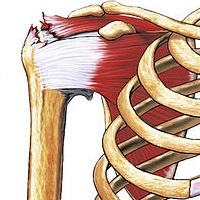
Photo from wikipedia
Abstract Background: There have been no published randomized clinical trial to assess the clinical outcomes between the articular-sided and bursal-sided tears. Therefore, a comparative analysis of evaluating and comparing the… Click to show full abstract
Abstract Background: There have been no published randomized clinical trial to assess the clinical outcomes between the articular-sided and bursal-sided tears. Therefore, a comparative analysis of evaluating and comparing the functional outcomes following arthroscopic repair of bursal-sided versus articular-sided partial-thickness rotator cuff tearsis essential. Methods: This study is a present randomized controlled trial which is conducted in our hospital. Consecutive patients with symptomatic articular-sided or bursal-sided partial-thickness rotator cuff tears underwent arthroscopic repair between June 2020 and January 2022. The institutional review board approved the study proposal (with number 10012030), and informed consent was obtained from all patients. Inclusion criteria were existence of an articular- or bursal-sided tear involving <50% of the tendon thickness—confirmed intraoperatively and treated with arthroscopic debridement with or without other decompression surgery (acromioplasty/distal clavicle resection)—and a minimum follow-up of 2 years. All patients followed the same postoperative rehabilitation program. The patients were assessed at baseline preoperatively, and at 1 year and 2 years postoperatively. Outcome parameters were measured at each respective follow-up, which included active range of motion in forward flexion and abduction of the affected shoulder, pain score as measured on the Numeric Pain Rating Scale, as well as outcome scores in terms of the Constant-Murley Score, and Oxford Shoulder Score. Results: Table 1 and Table 2 describe the data indicators that this article wants to evaluate and collect. Conclusions: We hypothesize that both groups of patients will show improvement in range of motion, functional outcome scores, and pain at 2 years, and that results would be similar between the two groups. Trial registration: This study protocol was registered in Research Registry (researchregistry6496).
Journal Title: Medicine
Year Published: 2021
Link to full text (if available)
Share on Social Media: Sign Up to like & get
recommendations!